Children of the present and gadgets of the past
Time flies incredibly fast. Technological advances are going nostrils with it, and we are already used to this, that we stopped paying attention to it. Fresh, hot with the heat, smartphones and tablets become morally obsolete six months or a year after the purchase, it is better not to remember about any video cards, televisions and cameras. Eighteen years ago, one could proudly get a pager, twelve years ago, carry a mobile phone in a case on a belt, seven years ago the world was “blown up” by the first iPhone and the era of smartphones began. In general, the process starts to spin out of control.
The childhood of each generation is marked by material objects characteristic of that time. Previously, the change of technology was fairly smooth and slow, so children usually knew and understood what was once valuable and important to the previous generation. But today there is such an infinite variety of all kinds of gadgets and electronics around that in fact there was a gap in the continuity of generations.
We decided to conduct a small experiment - to invite six children from six to ten years old and show them the gadgets from the recent past.
')
Well, how to explain to a person who was born in 1995, why this picture is nostalgic for those born in 1980?
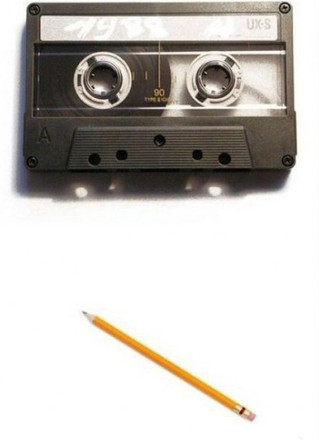
And this picture generally squeezes a mean male tear from a thirty-forty-year-old generation:
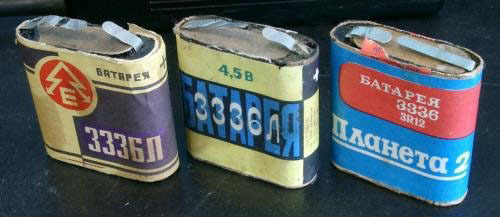
And how can modern young people understand the joy that the practical experience of communication with these household galvanic elements brought us? This, in the literal sense of the word, the unique taste of childhood ?
Many of us have long (or recently) become parents. We had the idea to make a video about what modern children know about gadgets from our own childhood. Our children already live in a completely different country; they are surrounded by another world, gadgets and technologies that were unknown to us at their age. In the video, we decided not only to ask the children if they know what objects and devices we show them, but also how to use them. Yes, we ourselves have forgotten about many things. Let us together recall some of the things that were so important for tens of millions of people.
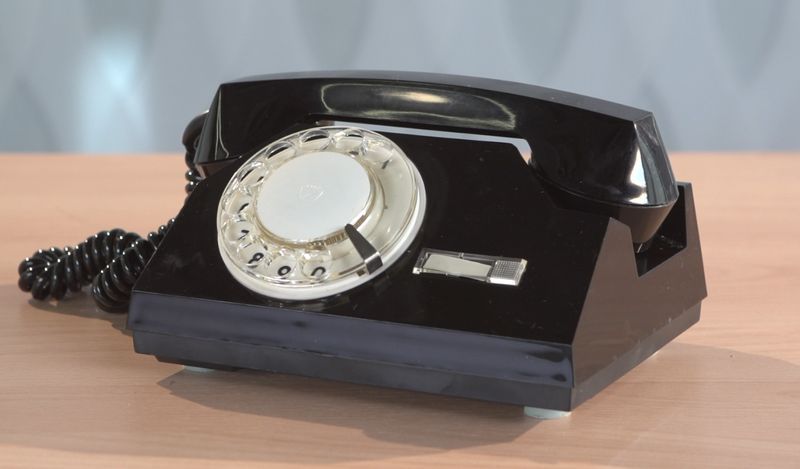
The most famous gadget in our video. Perhaps a dial-up telephone is one of the most recognizable devices of all time. To be honest, we are even a little sorry for those who have never used a similar method to dial a number.
For many decades, the home phone was not available to everyone. I had to go to the neighbors to call, or go down to the pay phone. At one time, this rather slowly returning disc could bring to a white-hot, while you were hastily dialing a number. We didn’t get into the necessary holes, but it happened that we twisted the disc so sharply that the whole phone crawled on the table. How many years have passed, and in the memory immediately there is a buzzing of the returning disk, tactile sensations from the holes and the limiter, which rested against the finger while typing.
“Oh, they've already answered!
Well hello, it's me ... "

Millions of people around the world who did not want to comprehend the science of photography, with joy and gratitude, took this vicious, from the point of view of real fans of photography, the invention of Polaroid. Strange, massive and unsightly apparatus, which did not require any knowledge and settings, after clicking on the trigger, spat out a small piece of cardboard, on which after a while an image appeared before your eyes. No excerpts and diaphragms, development and sorcery over the enlarger. Click on the button - you will get the result, the apotheosis of consumer simplicity and efficiency. To speed up the manifestation, knowledgeable people recommended shaking the card after leaving the camera.
Plastic lenses and a lens exposed at a hyperfocal distance a priori did not allow us to speak of a qualitative image. However, the consumer voted with the ruble, and the polaroid pictures filled the planet. Of course, in our country, the cost of both the camera itself and the cassettes for it were very high compared with conventional film “soap dishes”, which greatly restrained the prevalence of this gadget. Nevertheless, it was not such a rare device in the families of the former Soviet Union. Many still have Polaroid photos at home, although there were cases when the image disappeared several years later.
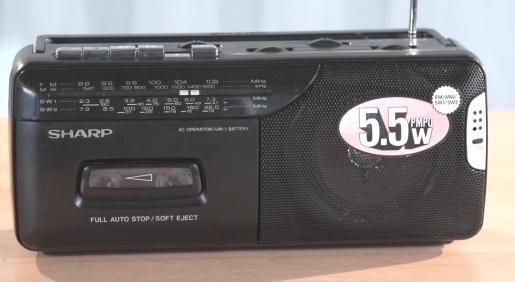
The very device on which compact audio cassettes were played and recorded. Perhaps, before the advent of VCRs, this was one of the main tekhnofetyshe in the USSR. Soviet industry produced mono and stereo recorders, many of which were very expensive, their cost could be 2-4 salaries of the ordinary citizen of “one sixth land” (we will not take the meager share of the lucky ones who had imported tape recorders brought by relatives and useful acquaintances from international business trips).
In tape cassette recorders, two-way rewind was appreciated, so that you could rewind the tape without taking it out and turning it over. A special chic was the smooth opening of the cassette receiver lid; in most Soviet tape recorders, without any constraint, it was snapped open by the action of a spring, like a devil from a snuffbox. Particularly advanced owners of tape recorders were sometimes screwed up with a screwdriver with a clamping screw on the pickup head to improve the sound quality.
Today, anyone can put files on the tracklist in the player, and nowadays successful collections of songs on tapes have gone around hands and replicated many times. And with trepidation and pleasure we then listened to all these hissing and luminous recordings of 3-5 spinning. In order not to inadvertently record something on top of valuable music, you could use a one-time mechanical fuse - break the plastic tab on one of the ends of the cassette. However, when tastes and priorities changed, and it was necessary to re-record the cassette, the resulting hole was sealed with a piece of electrical tape (not scotch, then it was not there) or plastered with clay.
By the way, if for you the meaning of the very first picture in this post is a mystery: with the help of a pencil or a pen with a faceted body, the cassettes were rewound by hand. Why it was impossible to do it on a tape recorder? It happened that the film was pulled out of the cassette by the head of the tape recorder, and it got stuck - “the cassette was chewing”. Then it was necessary to carefully remove it, carefully pulling out the crumpled film loop and carefully winding it into the cassette by hand. Doing this with your finger was inconvenient and a bit unpleasant because of the teeth of the coils, so the inserted pencil was the perfect solution, at times increasing the speed and comfort of this procedure.
And many more with the help of a pencil just rewound the tape, and completely. Holding the pencil vertically with a cassette mounted on it, they made quick rotational movements with a brush, which is why the cassette itself was spinning around the pencil. Of course, it was possible to rewind on a tape recorder, but it was not always at hand. And you need to rewind the tape, here's a paradox. So to say, from the field of the irrational.
Shortly after the collapse of the USSR personal monoblock computers appeared in the country. The most popular were numerous variations on the theme of the ZX-Spectrum . They did not have built-in data storage and only had RAM. Therefore, all the programs for them were stored on audio cassettes, and for the work it was necessary to pre-read them using a tape recorder in the computer's memory. Those who did this are unlikely to forget that cacophony of sounds, and the intense waiting for the end of the download with excitement - will there be a failure in reading or not. But that's another story, about the whole IT subculture of that time.
And if it was cool to have a stereo tape recorder to listen to music, they preferred to use mono tape recorders to work with the ZX-Spectrum, since it was believed that data reading errors occurred less often.
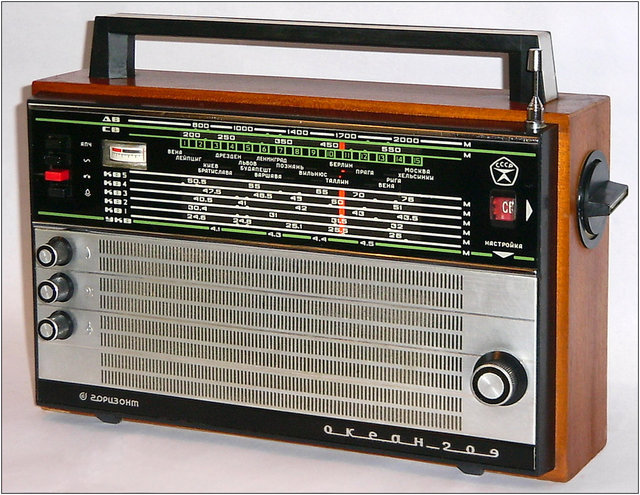
Once the tape recorders were still too expensive, so the radios were the most popular gadget in the country. With their help, we not only listened to “I’ll gnaaaaa a bicycle” and “Uchkuuuuuuk - three wells!”, But also listened to various informational, educational and political programs. A sort of portable entertainment-news portal on batteries, cheap and cheerful. Advanced models could take in a wide range of radio waves, and "witchcraft" with the dial was a whole ritual. And it was impossible for modern children to understand what a pleasure it was when, after intense listening to the hissing and crackling of the ether, they managed to catch some station.
Gradually, the tape recorders began to force out the radio receivers, since, having comparable dimensions, they had one incomparable advantage - they could listen to what they wanted, and not what they broadcast.

In the early nineties, video recorders became much more accessible, and the counters of cities and cities filled up video tapes. Most often, they were recorded 2 films or a bunch of cartoons. Video salons, which appeared in the houses of culture and various basements contributed to the popularization of Hollywood cinema. Do you remember these handwritten posters with the repertoire, hung around the city?
And now watching the video has become one of the most fashionable and popular ways of spending time at home and away. Therefore, for those who are now between 25 and 40, videotapes are invariably associated with many discoveries in the cinema, with surprisingly strong feelings from watching the then so unusual foreign films. Associated with childhood.
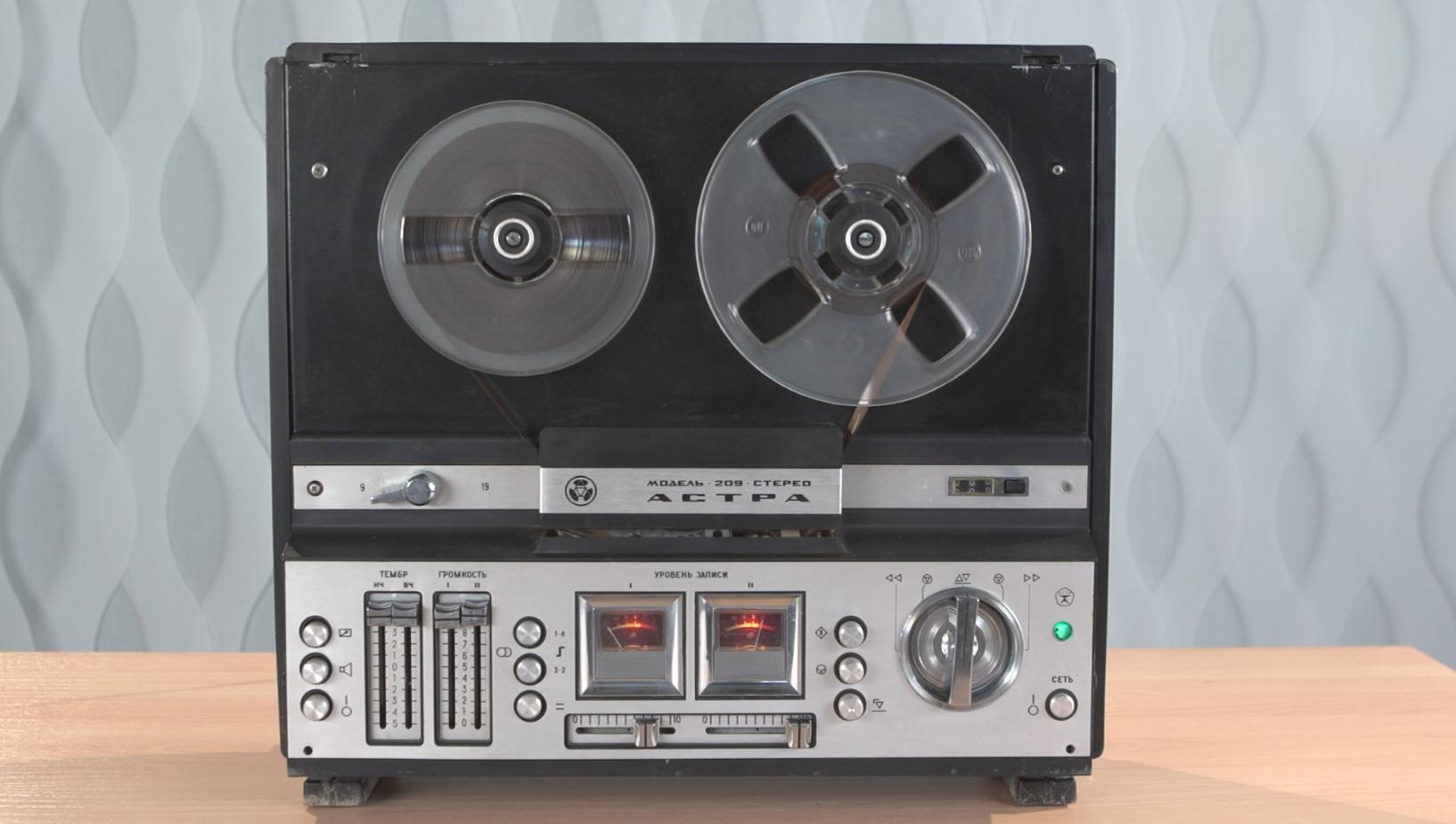
If a cassette tape recorder is familiar to almost everyone today, then its predecessor, the reel-to-reel tape recorder , was not even encountered by many of the generation of 30-year-olds. By the end of the 1980s, Soviet citizens had few of them left. Large and expensive, "reels" were purchased mainly by music lovers and audiophiles who could afford them. In contrast to the more compact and lightweight cassettes that appeared later, the reel-to-reel recorders were mostly stationary. Yes, and not too many were willing to take on the nature of expensive machinery with many open sensitive parts, including rotating ones.
Reel tape recorders became, in fact, the first and for many decades the only way to preserve and play your favorite music. It is thanks to the ease of replicating music recordings with the help of tape recorders to the nation-wide fame of many performers.
Of course, the weakest point of these gadgets was the very principle of storing and playing the film - on two independent coils (reels). The long open path with heads and a tape drive mechanism also did not improve security. In general, these tape recorders required careful handling and accuracy. But, if the film was torn, it was easier and easier to glue it than in the case of cassettes.
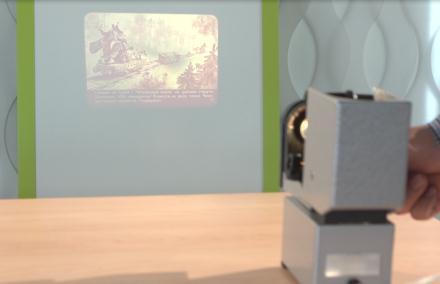
Long ago, when only television and books were the main entertainment at home, children really wanted something fabulous. And some bright head came up with the idea: why not make a simple device, so that the children themselves showed colorful stories. And nothing special is needed for this, except for the light bulb and the age-old technology invented to show people the cinema - 35 mm films. And so was born one of the best gadgets for children, slide projector.
You are not lucky with a bated breath to scroll in the dark film, looking at the sheets appear on the sheet? Then this is the essence of the overhead projector: a positive (slide) photographic film is passed through a box in which it is illuminated by a light bulb and is projected through a lens onto some bright surface. Miniature film projector, only manually operated.
The films were sold in small cylindrical boxes with lids, plastic or aluminum. Each film consisted of 10-20 frames, which were depicted with colorful pictures and short texts. Stories in miniature, a variety of comics.
It was a whole ritual - turn off the lights, shut the windows tightly, hang a sheet or release a piece of the wall. Refill the film, turn on the projector and immerse yourself in the contemplation of large projected images. You were yourself a cinema and a projectionist, lacking only ice cream, a blue helicopter and water on the asphalt river.
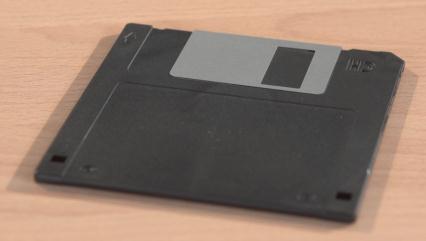
Once a personal computer without a three-inch drive was simply unthinkable. Have you caught those times? The small slot with the button below it was the same unchanged attribute as the keyboard. Floppy disks were vital - an operating system was installed from them, any data was stored and transferred to them. By the way, back in the early 1990s personal cards were distributed that did not have their own hard disk, so they were loaded exclusively from floppy disks.
Diskettes were the most popular storage medium. They sold a lot of programs, including large professional packages. Imagine a pack of 1.4-mb floppy disks on which the distribution kit of the same Windows or Corel Draw is written.
Any self-respecting IT specialist or computer enthusiast had a portable box with floppy disks in his bag. Many saved on cost by buying models for 720 kb and making 1.4 megabytes out of them by cutting out the second hole in one of the corners of the floppy disk. Yes, the reliability of data storage decreased, but who did not risk, he did not double the available memory.
Do you remember this mechanical slider that protects a floppy disk from writing? Which of us, in moments of nervous tension, did not click them back and forth, or with a metal curtain covering the holes for the heads?
It so happened that the heyday of 3-inch floppy disks fell on the period of rapid development and development of IT. Their significance was so great that the images of floppy disks are still constantly caught our eye, although the floppy disks themselves are not so easy to find. And therefore it is now difficult to explain to children that the strange icon indicates the function “Save” in the vast majority of applications on all computer platforms, stationary and mobile.
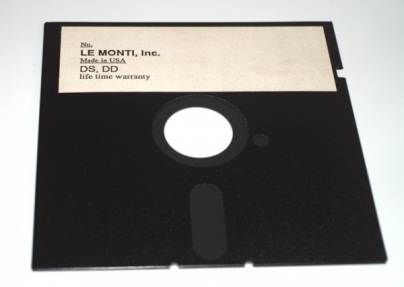
Question for backfilling for young people: where does the 5-inch diskette have a write-protect slider? Hands off Google! Of course, this is a joke - they did not have a slider. To protect a floppy disk from writing, it was necessary to glue it with a piece of paper or tape (the tape was still ephemeral exotic) on the right slot. The diskettes themselves were worn neatly in paper envelopes, and often the boxes for them were made independently. In order to facilitate the search for the desired floppy in the stack, many glued colored paper strips to the end.
Again, going back to the ZX-Spectrum: while most owners were boiling with cassettes and tape recorders, downloading a game for a few minutes, some could boast of having a 5-inch drive, which gave a multiple gain in download speed. True, floppy disks could store less data than a standard cassette, but it was a small fee for convenience, speed and reliability of reading.
A funny fact: people used to say that a 5-inch floppy can be neatly cut out of 8-inch floppy disks. Of course it was not. By the early 1990s, the five-inch rims had already been practically crowded out by three-inch diskettes.
That's all the gadgets that we showed to the small participants in our experiment. Finally, we want to thank them wholeheartedly! You did an excellent job with the recognition of all these strange for you and, in general, incomprehensible subjects. To be honest, we were surprised.
We congratulate all the rest on Children's Day!
Love them, be indulgent to them, because their small problems are no less important for them than yours are for you. And do not forget to tell them about the gadgets of their youth, so that they better understand you and your time when they grow up.
The childhood of each generation is marked by material objects characteristic of that time. Previously, the change of technology was fairly smooth and slow, so children usually knew and understood what was once valuable and important to the previous generation. But today there is such an infinite variety of all kinds of gadgets and electronics around that in fact there was a gap in the continuity of generations.
We decided to conduct a small experiment - to invite six children from six to ten years old and show them the gadgets from the recent past.
')
Well, how to explain to a person who was born in 1995, why this picture is nostalgic for those born in 1980?

And this picture generally squeezes a mean male tear from a thirty-forty-year-old generation:

And how can modern young people understand the joy that the practical experience of communication with these household galvanic elements brought us? This, in the literal sense of the word, the unique taste of childhood ?
Many of us have long (or recently) become parents. We had the idea to make a video about what modern children know about gadgets from our own childhood. Our children already live in a completely different country; they are surrounded by another world, gadgets and technologies that were unknown to us at their age. In the video, we decided not only to ask the children if they know what objects and devices we show them, but also how to use them. Yes, we ourselves have forgotten about many things. Let us together recall some of the things that were so important for tens of millions of people.
Disk phone

The most famous gadget in our video. Perhaps a dial-up telephone is one of the most recognizable devices of all time. To be honest, we are even a little sorry for those who have never used a similar method to dial a number.
For many decades, the home phone was not available to everyone. I had to go to the neighbors to call, or go down to the pay phone. At one time, this rather slowly returning disc could bring to a white-hot, while you were hastily dialing a number. We didn’t get into the necessary holes, but it happened that we twisted the disc so sharply that the whole phone crawled on the table. How many years have passed, and in the memory immediately there is a buzzing of the returning disk, tactile sensations from the holes and the limiter, which rested against the finger while typing.
“Oh, they've already answered!
Well hello, it's me ... "
Polaroid Camera

Millions of people around the world who did not want to comprehend the science of photography, with joy and gratitude, took this vicious, from the point of view of real fans of photography, the invention of Polaroid. Strange, massive and unsightly apparatus, which did not require any knowledge and settings, after clicking on the trigger, spat out a small piece of cardboard, on which after a while an image appeared before your eyes. No excerpts and diaphragms, development and sorcery over the enlarger. Click on the button - you will get the result, the apotheosis of consumer simplicity and efficiency. To speed up the manifestation, knowledgeable people recommended shaking the card after leaving the camera.
Plastic lenses and a lens exposed at a hyperfocal distance a priori did not allow us to speak of a qualitative image. However, the consumer voted with the ruble, and the polaroid pictures filled the planet. Of course, in our country, the cost of both the camera itself and the cassettes for it were very high compared with conventional film “soap dishes”, which greatly restrained the prevalence of this gadget. Nevertheless, it was not such a rare device in the families of the former Soviet Union. Many still have Polaroid photos at home, although there were cases when the image disappeared several years later.
Cassette recorder

The very device on which compact audio cassettes were played and recorded. Perhaps, before the advent of VCRs, this was one of the main tekhnofetyshe in the USSR. Soviet industry produced mono and stereo recorders, many of which were very expensive, their cost could be 2-4 salaries of the ordinary citizen of “one sixth land” (we will not take the meager share of the lucky ones who had imported tape recorders brought by relatives and useful acquaintances from international business trips).
In tape cassette recorders, two-way rewind was appreciated, so that you could rewind the tape without taking it out and turning it over. A special chic was the smooth opening of the cassette receiver lid; in most Soviet tape recorders, without any constraint, it was snapped open by the action of a spring, like a devil from a snuffbox. Particularly advanced owners of tape recorders were sometimes screwed up with a screwdriver with a clamping screw on the pickup head to improve the sound quality.
Today, anyone can put files on the tracklist in the player, and nowadays successful collections of songs on tapes have gone around hands and replicated many times. And with trepidation and pleasure we then listened to all these hissing and luminous recordings of 3-5 spinning. In order not to inadvertently record something on top of valuable music, you could use a one-time mechanical fuse - break the plastic tab on one of the ends of the cassette. However, when tastes and priorities changed, and it was necessary to re-record the cassette, the resulting hole was sealed with a piece of electrical tape (not scotch, then it was not there) or plastered with clay.
By the way, if for you the meaning of the very first picture in this post is a mystery: with the help of a pencil or a pen with a faceted body, the cassettes were rewound by hand. Why it was impossible to do it on a tape recorder? It happened that the film was pulled out of the cassette by the head of the tape recorder, and it got stuck - “the cassette was chewing”. Then it was necessary to carefully remove it, carefully pulling out the crumpled film loop and carefully winding it into the cassette by hand. Doing this with your finger was inconvenient and a bit unpleasant because of the teeth of the coils, so the inserted pencil was the perfect solution, at times increasing the speed and comfort of this procedure.
And many more with the help of a pencil just rewound the tape, and completely. Holding the pencil vertically with a cassette mounted on it, they made quick rotational movements with a brush, which is why the cassette itself was spinning around the pencil. Of course, it was possible to rewind on a tape recorder, but it was not always at hand. And you need to rewind the tape, here's a paradox. So to say, from the field of the irrational.
Shortly after the collapse of the USSR personal monoblock computers appeared in the country. The most popular were numerous variations on the theme of the ZX-Spectrum . They did not have built-in data storage and only had RAM. Therefore, all the programs for them were stored on audio cassettes, and for the work it was necessary to pre-read them using a tape recorder in the computer's memory. Those who did this are unlikely to forget that cacophony of sounds, and the intense waiting for the end of the download with excitement - will there be a failure in reading or not. But that's another story, about the whole IT subculture of that time.
And if it was cool to have a stereo tape recorder to listen to music, they preferred to use mono tape recorders to work with the ZX-Spectrum, since it was believed that data reading errors occurred less often.
Radio

Once the tape recorders were still too expensive, so the radios were the most popular gadget in the country. With their help, we not only listened to “I’ll gnaaaaa a bicycle” and “Uchkuuuuuuk - three wells!”, But also listened to various informational, educational and political programs. A sort of portable entertainment-news portal on batteries, cheap and cheerful. Advanced models could take in a wide range of radio waves, and "witchcraft" with the dial was a whole ritual. And it was impossible for modern children to understand what a pleasure it was when, after intense listening to the hissing and crackling of the ether, they managed to catch some station.
Gradually, the tape recorders began to force out the radio receivers, since, having comparable dimensions, they had one incomparable advantage - they could listen to what they wanted, and not what they broadcast.
Videotape

In the early nineties, video recorders became much more accessible, and the counters of cities and cities filled up video tapes. Most often, they were recorded 2 films or a bunch of cartoons. Video salons, which appeared in the houses of culture and various basements contributed to the popularization of Hollywood cinema. Do you remember these handwritten posters with the repertoire, hung around the city?
And now watching the video has become one of the most fashionable and popular ways of spending time at home and away. Therefore, for those who are now between 25 and 40, videotapes are invariably associated with many discoveries in the cinema, with surprisingly strong feelings from watching the then so unusual foreign films. Associated with childhood.
Reel to reel tape recorder

If a cassette tape recorder is familiar to almost everyone today, then its predecessor, the reel-to-reel tape recorder , was not even encountered by many of the generation of 30-year-olds. By the end of the 1980s, Soviet citizens had few of them left. Large and expensive, "reels" were purchased mainly by music lovers and audiophiles who could afford them. In contrast to the more compact and lightweight cassettes that appeared later, the reel-to-reel recorders were mostly stationary. Yes, and not too many were willing to take on the nature of expensive machinery with many open sensitive parts, including rotating ones.
Reel tape recorders became, in fact, the first and for many decades the only way to preserve and play your favorite music. It is thanks to the ease of replicating music recordings with the help of tape recorders to the nation-wide fame of many performers.
Of course, the weakest point of these gadgets was the very principle of storing and playing the film - on two independent coils (reels). The long open path with heads and a tape drive mechanism also did not improve security. In general, these tape recorders required careful handling and accuracy. But, if the film was torn, it was easier and easier to glue it than in the case of cassettes.
Slide projector

Long ago, when only television and books were the main entertainment at home, children really wanted something fabulous. And some bright head came up with the idea: why not make a simple device, so that the children themselves showed colorful stories. And nothing special is needed for this, except for the light bulb and the age-old technology invented to show people the cinema - 35 mm films. And so was born one of the best gadgets for children, slide projector.
You are not lucky with a bated breath to scroll in the dark film, looking at the sheets appear on the sheet? Then this is the essence of the overhead projector: a positive (slide) photographic film is passed through a box in which it is illuminated by a light bulb and is projected through a lens onto some bright surface. Miniature film projector, only manually operated.
The films were sold in small cylindrical boxes with lids, plastic or aluminum. Each film consisted of 10-20 frames, which were depicted with colorful pictures and short texts. Stories in miniature, a variety of comics.
It was a whole ritual - turn off the lights, shut the windows tightly, hang a sheet or release a piece of the wall. Refill the film, turn on the projector and immerse yourself in the contemplation of large projected images. You were yourself a cinema and a projectionist, lacking only ice cream, a blue helicopter and water on the asphalt river.
3-inch floppy disk

Once a personal computer without a three-inch drive was simply unthinkable. Have you caught those times? The small slot with the button below it was the same unchanged attribute as the keyboard. Floppy disks were vital - an operating system was installed from them, any data was stored and transferred to them. By the way, back in the early 1990s personal cards were distributed that did not have their own hard disk, so they were loaded exclusively from floppy disks.
Diskettes were the most popular storage medium. They sold a lot of programs, including large professional packages. Imagine a pack of 1.4-mb floppy disks on which the distribution kit of the same Windows or Corel Draw is written.
Any self-respecting IT specialist or computer enthusiast had a portable box with floppy disks in his bag. Many saved on cost by buying models for 720 kb and making 1.4 megabytes out of them by cutting out the second hole in one of the corners of the floppy disk. Yes, the reliability of data storage decreased, but who did not risk, he did not double the available memory.
Do you remember this mechanical slider that protects a floppy disk from writing? Which of us, in moments of nervous tension, did not click them back and forth, or with a metal curtain covering the holes for the heads?
It so happened that the heyday of 3-inch floppy disks fell on the period of rapid development and development of IT. Their significance was so great that the images of floppy disks are still constantly caught our eye, although the floppy disks themselves are not so easy to find. And therefore it is now difficult to explain to children that the strange icon indicates the function “Save” in the vast majority of applications on all computer platforms, stationary and mobile.
5 inch floppy disk

Question for backfilling for young people: where does the 5-inch diskette have a write-protect slider? Hands off Google! Of course, this is a joke - they did not have a slider. To protect a floppy disk from writing, it was necessary to glue it with a piece of paper or tape (the tape was still ephemeral exotic) on the right slot. The diskettes themselves were worn neatly in paper envelopes, and often the boxes for them were made independently. In order to facilitate the search for the desired floppy in the stack, many glued colored paper strips to the end.
Again, going back to the ZX-Spectrum: while most owners were boiling with cassettes and tape recorders, downloading a game for a few minutes, some could boast of having a 5-inch drive, which gave a multiple gain in download speed. True, floppy disks could store less data than a standard cassette, but it was a small fee for convenience, speed and reliability of reading.
A funny fact: people used to say that a 5-inch floppy can be neatly cut out of 8-inch floppy disks. Of course it was not. By the early 1990s, the five-inch rims had already been practically crowded out by three-inch diskettes.
That's all the gadgets that we showed to the small participants in our experiment. Finally, we want to thank them wholeheartedly! You did an excellent job with the recognition of all these strange for you and, in general, incomprehensible subjects. To be honest, we were surprised.
We congratulate all the rest on Children's Day!
Love them, be indulgent to them, because their small problems are no less important for them than yours are for you. And do not forget to tell them about the gadgets of their youth, so that they better understand you and your time when they grow up.
Source: https://habr.com/ru/post/224357/
All Articles